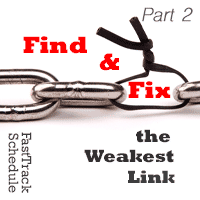 Communication is essential for a successful project. But not just communication – good and effective and accurate communication – because miscommunication happens all too often. Think about what happens in our homes every day. How many times has your wife or husband said they told you something or asked you to do something and you have no clue what they’re talking about? I’m hoping that’s not just me.
Communication is essential for a successful project. But not just communication – good and effective and accurate communication – because miscommunication happens all too often. Think about what happens in our homes every day. How many times has your wife or husband said they told you something or asked you to do something and you have no clue what they’re talking about? I’m hoping that’s not just me.
It’s the same way with our projects and our project customers. We try to document communications with our customers and get their signoff on expectations and understanding, but it isn’t always successful. What we sign off on may be a generality when in fact the details are up for interpretation. Some of that is just unavoidable because you can’t capture all details of a discussion unless you’re going to record every communication – and that’s just not reasonable.
Communication disconnects
Disconnects in customer communications and understanding can happen at a number of points throughout the engagement. They can happen:
- During the sales process
- During project kickoff
- On change requests
- During status calls and meetings
- During every informal oral communication
That last one is especially true, because when we put things in writing the likelihood of a misunderstanding or an incorrectly set expectation often diminishes. But I will never say that all customer communication should be handled via emails. That’s not practical and it takes too much of the human element out of the communication. However, email is an essential tool for delivery team–customer team communication and is often a great way to follow up to confirm understanding.
Preventative measures
There are three ways, in my opinion, that we can work to ensure that customer expectations are in line with what we – as the delivery team – see those expectations to be. Remember, there’s not guarantee and there are just about as many possibilities for interpretation as there are fingerprints on record… I’m trying to say we’re all different. But these three actions can help to ensure that we’re all on the same page during the engagement.
Revisit the sales materials with the client prior to kickoff. Prior to getting together for a formal project kickoff, meet with sales to understand how that process went and to get any of your questions answered that you might have concerning the sales handoff materials you’ve received. Then, meet with the customer – still prior to kickoff – to discuss the engagement at a high level and get more questions answered so that you can head into the project kickoff phase with your best possible understanding of the project goals and information.
Plan for and conduct a detailed project kickoff to set project expectations going forward. Do not skip this step. Hold a formal project kickoff with the customer – even if it has to be by phone if everyone can’t be in the room together. The key here is to get everyone on the same page before the project truly starts. If you skip this step, you risk – and it’s a huge risk – beginning work on the project with a mixture of expectations and as the project manager you know that’s a recipe for disaster.
Follow up all meetings and calls with email documentation of agreements that were made and ask for response acceptance. Always follow-up project status meetings and project status calls with emails to the participants documenting your understanding of the discussions that took place, the decisions that were made, and any action items or issues that came out of those discussions. And ask for responses back – including feedback – of either acceptance or changes that need to be made. The project manager is the communication central point on the project so you need to be sure that you have the information correct before proceeding because that information drives what you do next on the project and all of the changes you make to the project schedule and other various project documents.
Summary
There’s absolutely no way to guarantee that everyone’s project expectations and understanding are the same. But there are follow-up actions that we can perform to ensure that they are close and those customer signatures and response can sometimes go a long way in saving your company a lot of money if there is a disagreement down the road.



